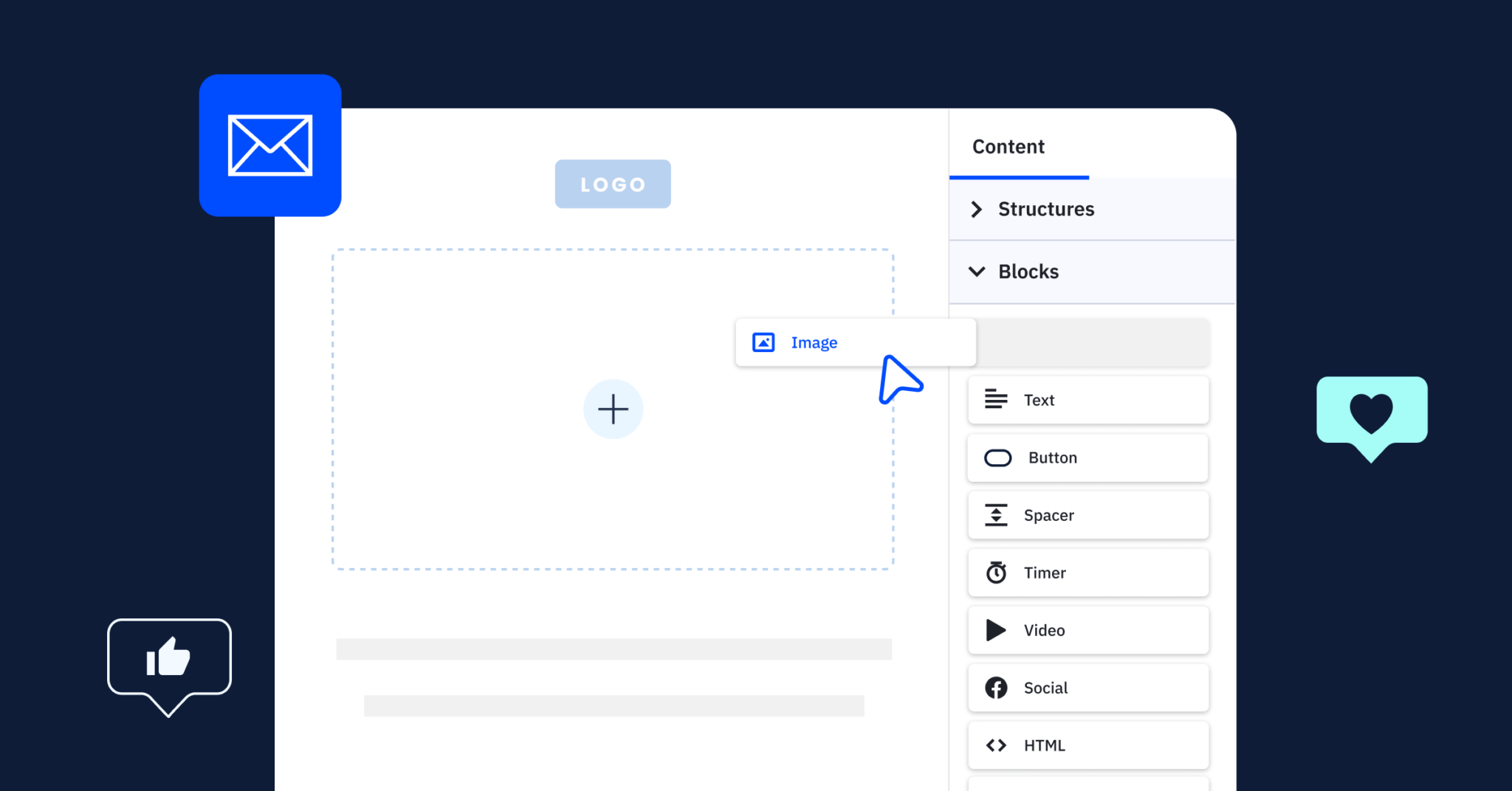Are you investing time, energy, and resources into generating leads but struggling to see bottom-line results? You’re not alone.
Many businesses focus so much on driving traffic and lead generation that they neglect the second half of the equation: turning those leads into customers.
Enter lead nurturing.
By developing a lead nurturing campaign, you’ll establish ways to cultivate deeper relationships with your leads. You’ll also uncover their needs and wants and be able to craft a strategy that meets those needs, turning a lead into a sale.
In this article, we’re covering everything you need to know about lead nurturing. We’ll talk about what lead nurturing is, the different types of lead nurturing, and how to create and measure a lead nurturing campaign.
What is lead nurturing?
Lead nurturing is the process of purposefully developing relationships with leads or contacts in order to move them down the sales funnel. Lead nurturing strategies help you convert more leads and use marketing resources more effectively.
Unlike lead generation, which is finding new prospects, lead nurturing focuses on getting to know those prospects and customizing your sales and marketing strategies and communication according to their needs and preferences.
Why is lead nurturing important?
Lead nurturing is becoming more important, too.
40% of marketing leaders said improving lead quality was their top objective for 2021, and 38% said their top priority was to drive increased sales across identified leads. Lead nurturing helps with both. You might already be using some lead nurturing tactics, but you don’t know.
Here are a few approaches you might be familiar with, making it easier for you to get started on a lead nurturing strategy:
- Email drip campaigns
- Email segmentation and personalization
- Remarketing or retargeting
- Lead quality scoring
- Content marketing strategy and distribution
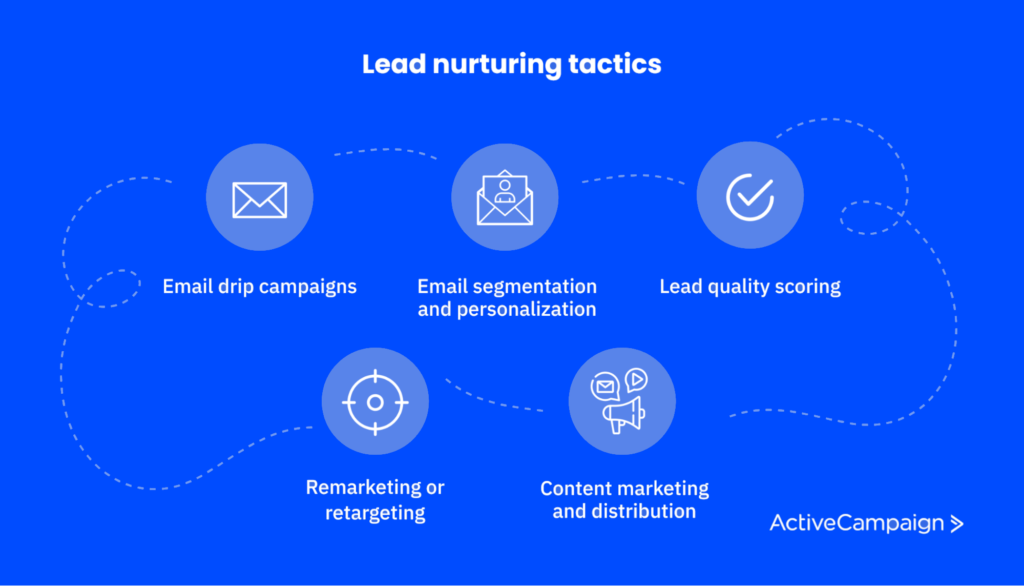
An effective lead nurturing program will likely use a combination of these tactics as the lead moves through the sales funnel. Using these tactics together in the right way will yield the best results for your sales team.
Best lead nurturing channels
Many channels are great for lead nurturing. Some of the best channels include:
Social media: Social media is great for lead nurturing since you can reach a huge number of prospective customers simultaneously. By creating and sharing valuable, relevant content on your social channels, you can build powerful relationships with your potential customers and track your progress as you go.
Email: Email marketing is one of the most effective channels for lead nurturing because it’s more personal than other platforms. Not only do emails offer businesses the chance to address their leads by name, but it also allows for a super-personalized experience.
Phone calls: Online platforms are extremely helpful in our busy, fast-paced world. Customers have become accustomed to receiving most communication online—which is why they often appreciate a phone call from a real person. Thus, phone calls are great for building personal connections and loyalty with customers.
Webinars: Not only do webinars allow you to reach large amounts of potential customers at once, but they also give you the opportunity to present yourself as an expert in your industry. Since webinars are also in video format, prospects get to see your face, which is great for building trust with them.
5 types of lead nurturing campaigns
A lead nurturing strategy can take many forms. It’s imperative to choose the right strategy to meet your business goals.
Here are a few examples of lead nurturing campaigns you can adapt to your needs.
Welcome campaign
Once prospects have signed up for your email list, filled out a contact form, or otherwise expressed interest in your company, send a series of emails introducing them to your company and offering detailed information about your products.
This series will form part of your top-of-funnel—which is excellent for getting prospects familiar with your brand and interested in your offers. 25% of marketers say that lead nurturing campaigns are one of the most effective top-of-funnel demand generation tactics.
Re-engagement campaign
Leads fall off at every stage of the sales cycle, but a re-engagement campaign works to get them back. Send new product information, your latest white paper, or a special deal to entice them back.
Product deep-dive campaign
When your lead is in the learning phase of the sales funnel, consider an informational campaign to educate them on every aspect of the product they’re most interested in.
Consider offering demos or meetings too. This approach is wildly popular, with at least 68% of marketers using ultra-valuable content to nurture leads.
Multichannel campaign
Consumers don’t spend their entire day in a single online space, so your sales team shouldn’t either. Track customers across platforms and provide multiple touchpoints so that you’re top-of-mind no matter where they are.
Promotional campaign
In the final consideration stages of the sales process, push to close the deal by offering special discounts, deals, and pricing.
There are plenty of other ways to approach a lead nurturing campaign. You can combine and adjust these tactics, depending on your needs. Just remember to focus on meeting the needs of your leads at every stage of the buying process whether they’re just starting out in the awareness stage or approaching the buying stage.
7 steps to create a lead nurturing strategy
With so many ways to nurture leads, it can be difficult to understand where to start building your lead nurturing program. By following these seven simple steps, you’ll create a framework for a lead nurturing strategy that turns more potential leads into sales.
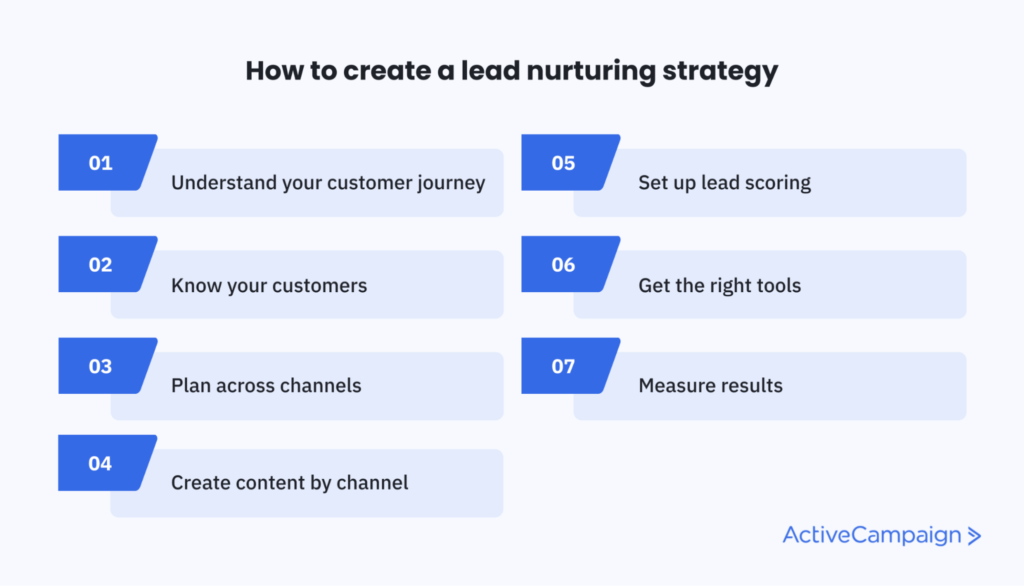
1. Understand your customer journey
Before you start planning your next drip campaign or retargeting ad, it’s critical to understand your customer journey. Outlining your sales funnel from start to finish helps you identify the touchpoints where you can nurture leads.
For instance, you might notice that conversions drop off rapidly after an initial boost from your welcome campaign. That’s a good opportunity to establish a re-engagement campaign or set up some education content marketing to catch your leads’ attention.
2. Know your customers
Lead nurturing requires a deep understanding of your customers so you can build a genuine relationship with them. To help you best do this, consider creating buyer personas to organize what you know about your loyal customers.
With a buyer persona or customer segmentation strategy, you can use customer information to understand their needs and pain points and develop approaches to address them.
A buyer persona should include:
- Demographic information like age and gender
- Geographic location
- Needs, wants, and pain points
- Habits and lifestyle
- Preferred online channels
Use this free buyer persona template to understand your ideal customers better and improve your messaging.
3. Plan across channels
As we mentioned above, your leads are unlikely to spend time exclusively on one online channel. It’s much more likely that they switch between email, Instagram, and other platforms regularly throughout the day.
Your lead nurturing strategy should take place across channels too. Choose the top channels for your audience and tailor your message to fit the ones you’re using, even if the content itself doesn’t vary greatly.
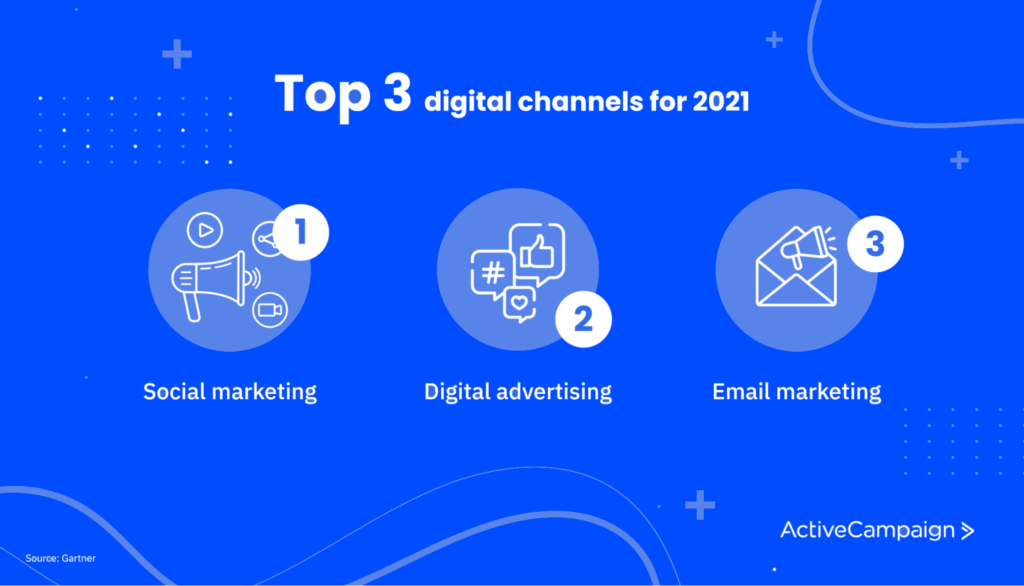
In 2021, 54% of marketers relied on social marketing as a top digital strategy channel. 53% of marketers used digital advertising and retargeting, while 44% relied on email marketing.
4. Create content by channel
No matter your digital strategy channel, you’ll need excellent, relevant content to engage and educate your readers.
Of course, the type of content you create will vary greatly depending on your marketing channels, lead nurturing strategies, and business goals. You might share a white paper on LinkedIn, a key statistic on Twitter, and a blog post summary via email.
The important thing is to make sure your content is as personalized as possible. Marketing automation software like ActiveCampaign even offers a dynamic content feature that uses customer information to write personalized emails, adding a special touch for your prospects.
5. Set up lead scoring
Lead scoring assigns point values to leads based on their actions so that marketing and sales teams can better serve them.
In a lead nurturing strategy, lead scoring is important for assessing which leads are ready to close the deal and which need a little extra attention before buying.
Some teams use lead scoring to define a qualified lead, while others might use it to note the difference between a sales lead and a marketing lead.
When you’re setting up your lead scoring criteria, consider using the following:
- Email opens or click-through rate
- Website visits
- Length of time spent on the website
- Social media likes or shares
- White paper or e-book downloads
Your lead scoring criteria should depend on the strategy you use to nurture leads. And, you should adjust your lead scoring over time to best reflect the value of your prospects’ choices.
For instance, an e-book download might signal a more valuable lead than an email open. Your lead scoring should reflect that.
6. Get the right tools
For a full-scale lead nurturing campaign, it’s smart to invest in a tool to help you automate parts of the customer experience. You can scale up your lead generation and nurturing programs while still providing personalized, top-quality customer service using tools like a cloud contact center, help desk ticketing system, customer retention software, etc.
Marketing automation software like ActiveCampaign is a huge asset to lead management and nurturing.
84% of marketers say AI and automation allow them to deliver real-time, personalized experiences to their customers. But, only 17% are using AI across their marketing efforts.
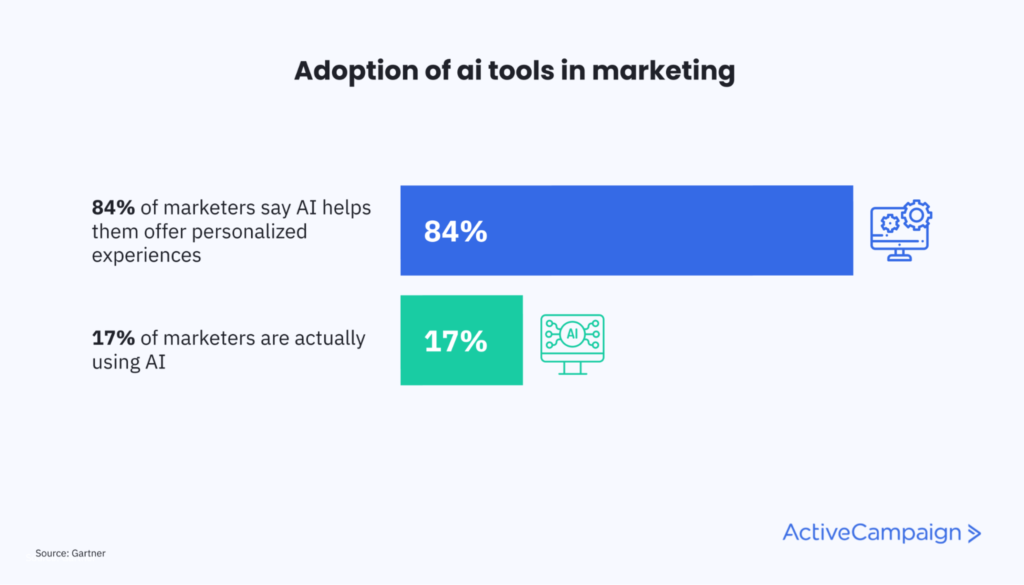
That means you have a chance to stand out and offer unparalleled customer experiences to your leads, crushing your competition.
7. Measure results
Like most business processes, you probably won’t have a perfect lead nurturing strategy on the first try. You’ll need to tweak and optimize your process as you start to see results.
Use your marketing data to identify weaknesses in your lead nurturing process. Then, make gradual changes to see if the adjustments yield the results you want.
The next section will examine how to measure your lead nurturing results.
How to measure your lead nurturing campaign results
Before you launch a lead nurturing campaign, it’s crucial to establish a baseline for your lead-to-sale conversion rate.
You can use existing data to calculate this over the last month, quarter, or year. Use this number to compare the difference in conversion before and after nurturing leads.
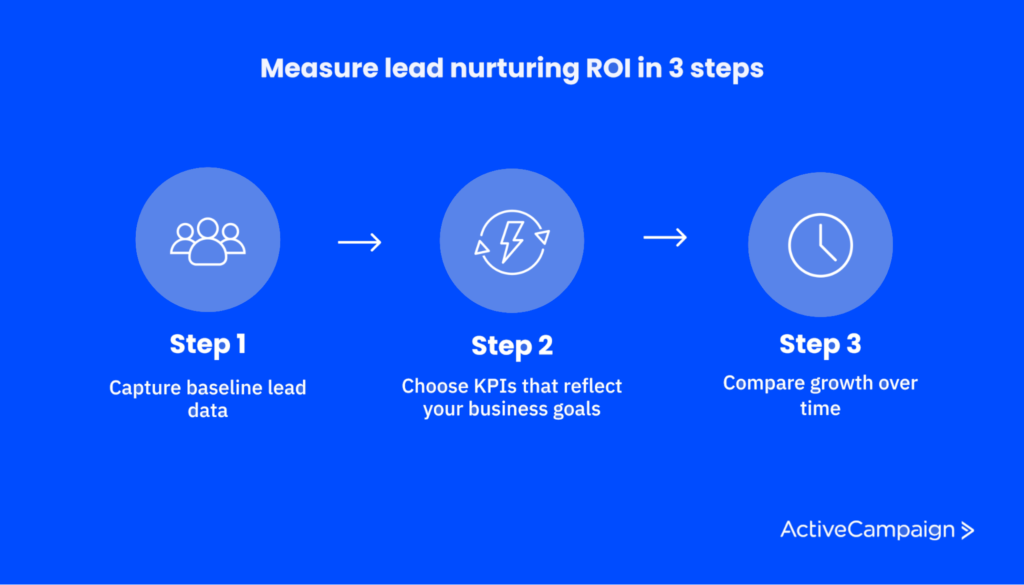
Then, choose key performance indicators (KPIs) that best show whether you’ve met your lead nurturing goals. Conversion rates will almost always be one of these KPIs, but you can also track sales, revenue, average revenue per user, customer engagement, and more.
Next, compare your growth over time. Remember that lead nurturing can be a long process, especially for B2B marketing teams. Be sure to allow for enough time to see the right results.
If you’re just getting started with lead nurturing, you might also consider starting with a lead nurturing test group. Then, you can compare your nurtured leads to non-nurtured leads to see how effective your strategy is.
No matter how you do it, measuring results is necessary to sustain your lead-nurturing success and optimize your results moving forward.
How to set up your next lead nurturing campaign
We’ve covered a lot about lead nurturing, but we’ve got a few more tips to help you start on the right foot. No matter how you decide to use lead nurturing, follow these tips and best practices:
1. Use different content formats
Even if you’re trying to get the same message across, use different formats such as blog posts, social media posts, and short videos to accommodate many different types of consumers.
You can repurpose and repost this content across channels to get the most out of your creations.
2. Leverage A/B testing
Studies show that 79% of marketers use tests to compare the effectiveness of their message across channels, and you should too. You can split-test dozens of elements of your lead nurturing campaign to hone in on exactly what gets potential customers to buy.
Learn more about split testing by reading our comprehensive A/B testing guide.
3. Personalize the little things
You can customize everything from the subject line to sending time when it comes to email campaigns. And if you’re like most organizations, you’ll find that your conversion rate rises when your level of personalization is effective.
4. Start small and scale up over time
Jumping headfirst into a company-wide lead nurturing strategy could do more harm than good.
If you’ve got the wrong approach, you risk turning away more leads than you nurture. Instead, start with small marketing campaigns and groups of customers, and gradually expand your lead nurturing program as you learn more.
5. Always stay on topic
Consumers are inundated with information online, so don’t add to the clutter. Stick to the point of your latest nurturing campaign rather than trying to entice a lead with something they may not want or need.
Frequently asked questions
What is the difference between cold, warm, and hot leads?
Cold leads are people who unknowingly need what you have to offer but show no interest in your business. They’re the people you’ll need to educate about your products or services and convince them to purchase from you.
Warm leads are people who show some interest in your business but haven’t decided which business they want to purchase from—you or your competitors. Hence, you’ll have to convince them you’re the right choice.
Hot leads are the people who are very interested in your product or service and often just need that final push to get to a purchase decision (by biting on a discount or special offer).
How long should a nurturing campaign be?
The timeframe of your nurture campaign will depend on the channel you’re using and the prospects you’re targeting (i.e., warm or cold leads).
It’s recommended that your nurture campaign should be between 6 to 45 days long. However, your campaigns can be longer if you’re trying to nurture your leads for a high-ticket (high-priced) offer in the near future.
How many emails should be in a nurturing campaign?
Your email nurturing campaign should consist of at least three emails. However, the number of emails you send will depend on your nurture campaign’s timeframe.
For example, if your nurture campaign will run over four months, you can decide to send a nurture email once every two weeks with your preferred email marketing software.
If your nurture campaign is longer and you don’t have the time to create 20+ emails, you could also choose to send between 1 to 10 nurture emails and then divert them to regular newsletter emails.
Using marketing automation to elevate your lead nurturing strategy
Enlisting the help of a marketing automation platform allows you to create customizable, relevant emails at scale to power your lead nurturing strategy. Automation software is immensely powerful and is an incredible avenue to build and strengthen your customer relationships while keeping them engaged through their specific customer journey.
Specific examples of lead nurturing emails you can automate include:
- Newsletters
- Discount codes after they visit a page
- Reminder emails
- Product updates
Just remember that most customers want to be understood, not treated as a dollar sign. Finding ways to incorporate these interactions organically in your lead nurturing process is the key to maintaining good rapport with your email list.
Deliver the best possible customer experience by sending them relevant and timely communications they’re actually interested in. This can be done when you fold automation into your strategy. With ActiveCampaign, you can set up triggers that start an automated drip campaign that’s specific to that customer’s behaviors.
Nurture your leads into sales starting now
Lead nurturing helps you build meaningful relationships with leads to convert more of them into sales. With buyer personas, customer data, and a lead nurturing tool in hand, you’ll be ready to convert more leads than ever before, creating high-quality leads and perfecting the buyer journey.
Use our guide and check out the ActiveCampaign blog for more on how you can meet your customer needs, improve your conversion rate, and boost your bottom line.
Ready to get started and automate your lead nurturing efforts? Sign up for a free 14-day trial of ActiveCampaign below.


